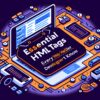How to Use HTML Attributes to Improve Your Website’s Accessibility

Enhancing Website Accessibility with HTML Attributes
Understanding HTML Attributes
HTML attributes play a crucial role in web development, providing additional information about elements on a web page. By effectively leveraging these attributes, developers can significantly improve website accessibility, ensuring a more inclusive and navigable experience for all users, including those with disabilities.
Aria-label: A Gateway to Accessible Web Navigation
One of the most powerful attributes for enhancing accessibility is ;aria-label>. This attribute allows developers to provide a text description for screen readers, which is particularly useful for users who rely on assistive technology to navigate the web. For instance, adding an ;aria-label> to input elements and links can make forms and navigation menus much more accessible.
Alt Text: Making Images Accessible
The ;alt> attribute is a staple for making images accessible on the web. By providing a concise, descriptive text alternative for images, you ensure that users who cannot see the images can still understand their context and relevance. This is not only beneficial for screen reader users but also improves your website’s SEO.
Using the Lang Attribute
The ;lang> attribute is essential for specifying the language of a page’s content. This helps screen readers pronounce content correctly, improving the user experience for non-native speakers and users with disabilities alike. Specifying a language with the ;lang> attribute is a simple yet effective way to make your website more accessible.
Leveraging Tabindex for Keyboard Navigation
Keyboard navigation is paramount for many users, particularly those who cannot use a mouse. The ;tabindex> attribute can control the order in which elements are focused when navigating through a website using a keyboard. Proper use of ;tabindex> ensures that all elements of a site, including forms, links, and buttons, are accessible to keyboard-only users.
Conclusion
Incorporating these HTML attributes into your web development practice can vastly improve the accessibility of your website. By focusing on attributes like ;aria-label>, ;alt>, ;lang>, and ;tabindex>, developers can create more inclusive websites that offer a better user experience for everyone, regardless of their abilities or disabilities. Remember, accessibility should not be an afterthought in web design; it’s a crucial aspect that reflects the quality and inclusivity of your website.


